Ever found yourself pondering, “Does hot glue really work on wood?” Let’s dive into this sticky subject and unravel the truth together. Ready for a crafty adventure? Let’s go!
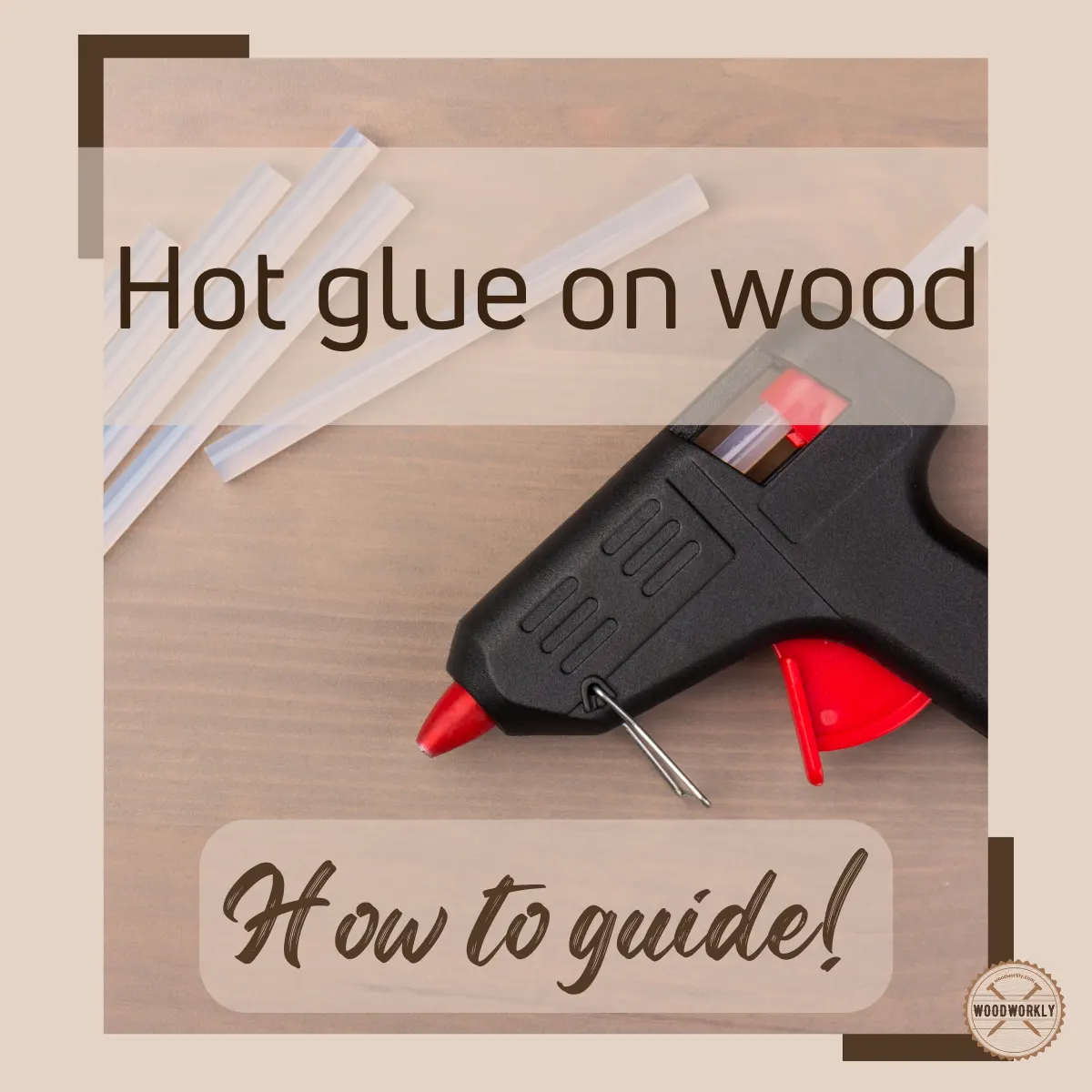
Hot glue is incredibly useful for adhering two pieces together, whether they are porous or non-porous surfaces.
From my experience, though, hot glue is not the best choice for high-strength applications. However, it excels when it comes to filling jobs.
I have been using hot glue for quite a while, and I understand that you’re curious about its effectiveness on wood.
No need to worry! I’ve got you covered.
So, let’s find out, Does hot glue work on wood?
Yes, hot glue work on wood to make durable joints for crafting, and installing windows, doors, and floorings. Hot glue hardens quickly on wood by making a versatile bond. But hot glue is not suitable for heavy duty projects since it doesn’t provide the same strength as wood glue.
But that’s just a quick snapshot of the question!

So, in this article, I’ll explore does hot glue work on wood and how to use hot glue on wood properly without messing things up with easy tips and techniques that I learned with experience.
Plus, I’ll answer some frequently asked questions as well.
Ultimately using hot glue on the wood question has no quick yes or no answer. It depends on the occasion that you’re willing to use it.
So, let’s jump in!
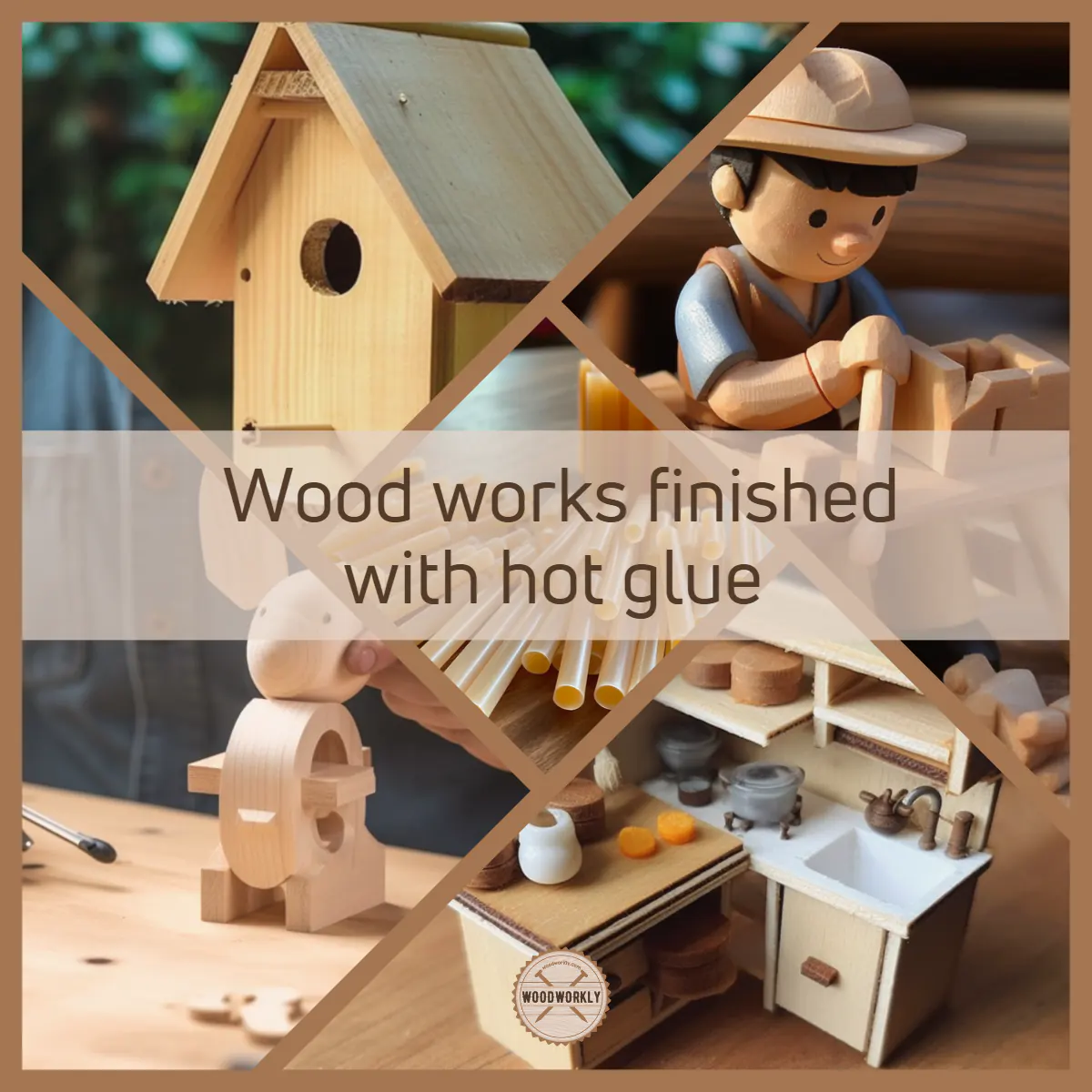
How Strong Is Hot Glue on Wood?
Hot glue is able to make a versatile durable bond with wood to make wood clamps and joints. But in terms of strength, those bonds are not good as expected.
With enough force, the bonded wood pieces can be pulled off so easily.
Also, certain things don’t work with hot glue and it doesn’t make a strong bond among the wood pieces.
The joint that makes by hot glue depends on the sticky surface tension which is measured by hot glue’s contact between the wood pieces to adhere.
Hot glue is made of a thermoplastic polymer combined with wax, mobilizers, and tackifiers. Those ingredients give adhesive properties to the hot glue.
If the joint created by hot glue begins to face a lot more tension, and shear stress than the contacted area of two faces, the joint will fail due to poor strength.
If the joint that you’re willing to make with hot glue doesn’t get affected by shear and stress it won’t break so easily and has a pretty good amount of strength.
So, you can support the joint made with hot glue with a screw or two, it won’t fail even under stress and shear.
Ultimately even though hot glue work on wood it will not create a strong wood-to-wood bond for structural purposes.
Hot glue bonds are strong enough for crafting projects but not for large construction projects.
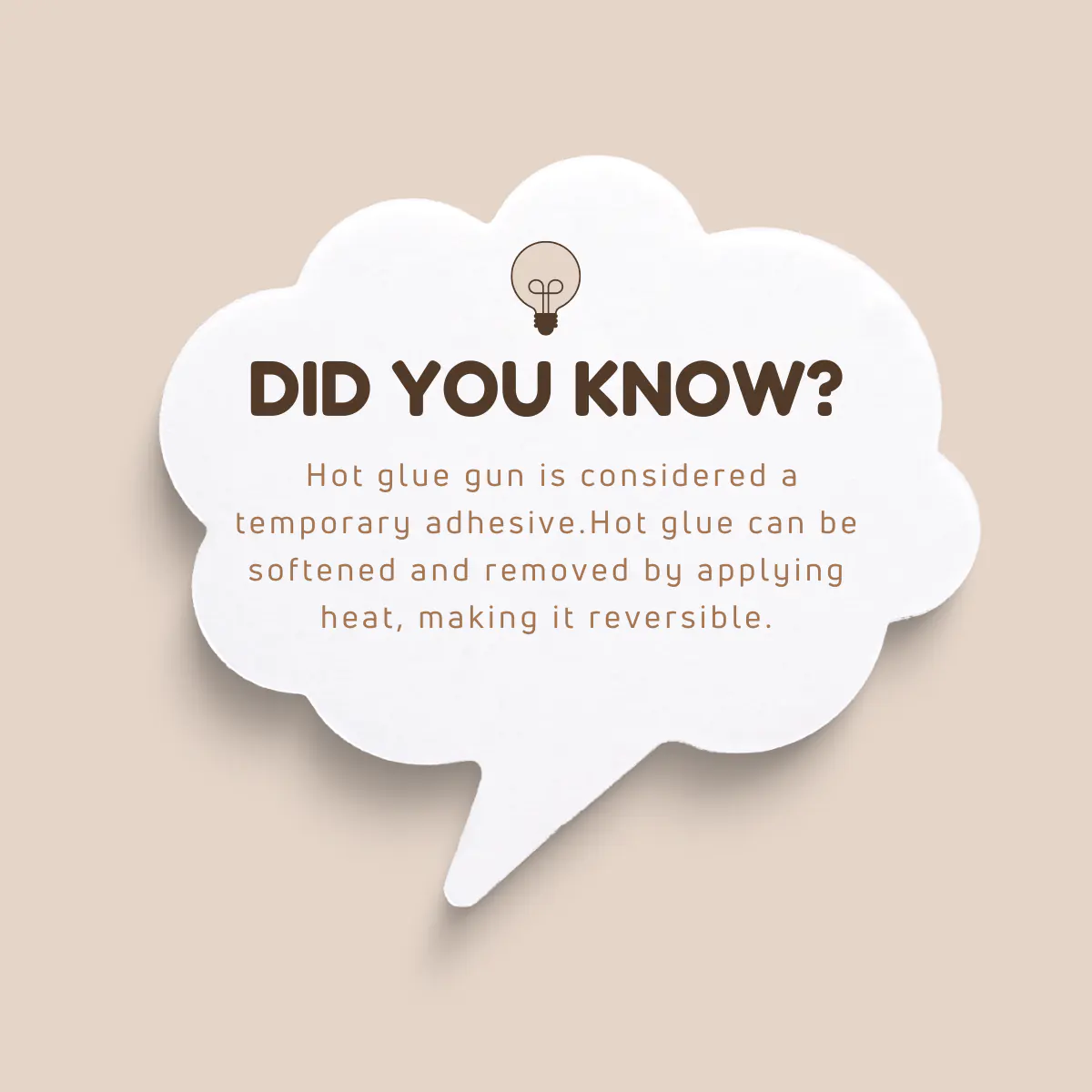
Is Hot Glue Good For Wood?
Hot glue is good for wood under certain circumstances. It’s excellent for quick fixes, crafts, small DIY projects, and temporary solutions.
It’s easy to use and bonds quickly. However, for larger, weight-bearing, or long-term projects, you might want to explore other more robust adhesives.
The answer isn’t as straightforward as a simple yes or no—it actually depends on various factors like the nature of the project, the type of wood being used, and the weight the joint needs to carry.
Let’s delve into these aspects to give you a comprehensive answer.
Hot Glue On Wood
Hot glue can indeed be beneficial for woodworking projects, provided it is used correctly.
This adhesive can create a strong, durable bond, especially when used on raw, non-smooth wood surfaces.
So, whether you’re joining wood pieces together, filling gaps and holes, attaching hardware, or creating decorative accents, hot glue can be your go-to adhesive.
An example could be a small DIY project, where you’re trying to create a birdhouse.
Hot glue can be instrumental in piecing together the wood components quickly and easily.
However, you need to remember that its use is best suited for less weight-bearing items due to its strength limitations.
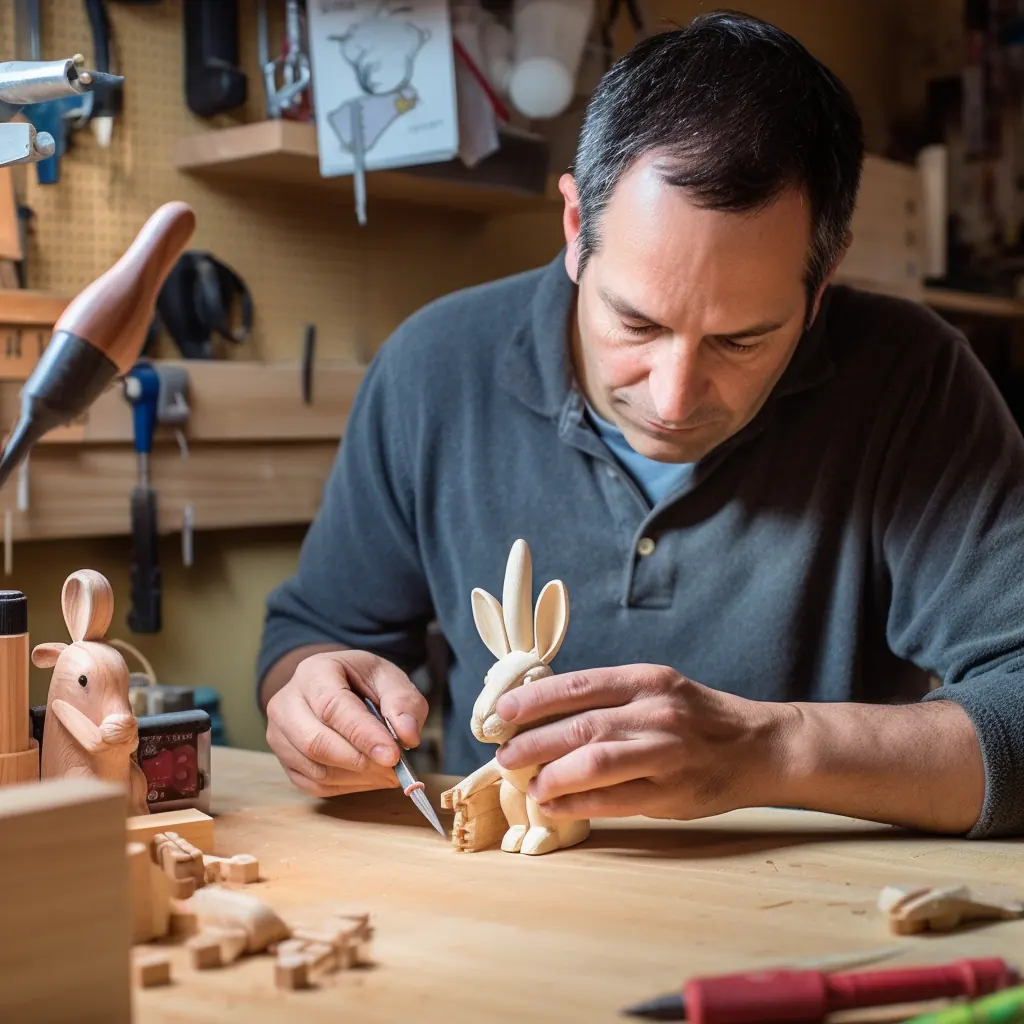
Using Hot Glue For Wood Projects
Here are some tips to consider when using hot glue for your wood projects:
- Use a Glue Gun Suited for Wood: Not all glue guns are the same. For wood projects, use a glue gun with a higher temperature setting to properly melt the glue.
- Apply Glue to Both Surfaces: Applying hot glue to both surfaces you intend to bond will result in a stronger bond.
- Press and Hold: Once you’ve applied the glue, press the wood pieces together and hold them for a few seconds. Hot glue cools quickly, so your hands will do just fine—no need for a clamp!
Limitations of Hot Glue on Wood
- Bonding Strength: While hot glue can form a decent bond, it is not as strong as other adhesives like wood glue or epoxy. It is typically best used for lightweight projects.
- Not Suitable for Weight Bearing: Hot glue is generally capable of supporting between 10 to 25 pounds. Therefore, for projects that require supporting heavier weights, hot glue is not the ideal adhesive.
- Not Permanent: Hot glue isn’t permanent and can peel or break away over time, especially from smooth or finished wood surfaces.
- Limited Durability: Hot glue may not be as durable or long-lasting as other types of adhesives. Over time, the bond can weaken, particularly in fluctuating temperatures or under consistent stress.
- Sensitivity to Temperature: Hot glue can soften and lose its adhesive properties under high temperatures. Hence, it is not ideal for applications that may be exposed to high heat.
- Surface Suitability: Hot glue tends to adhere better to raw, non-smooth wood surfaces. For polished or treated wood, it might not stick as effectively.
- Inefficient for Large Projects: For large-scale woodworking projects, the application of hot glue can be time-consuming and less efficient than using stronger, more suitable adhesives.
- Poor Gap Filling: Unlike some other adhesives, hot glue is not very effective at filling gaps. If the wood pieces you are joining do not fit together perfectly, hot glue may not provide a strong, secure bond.
Now I’m going to share with you some of the best hot glues in the market which I personally recommend for many projects.
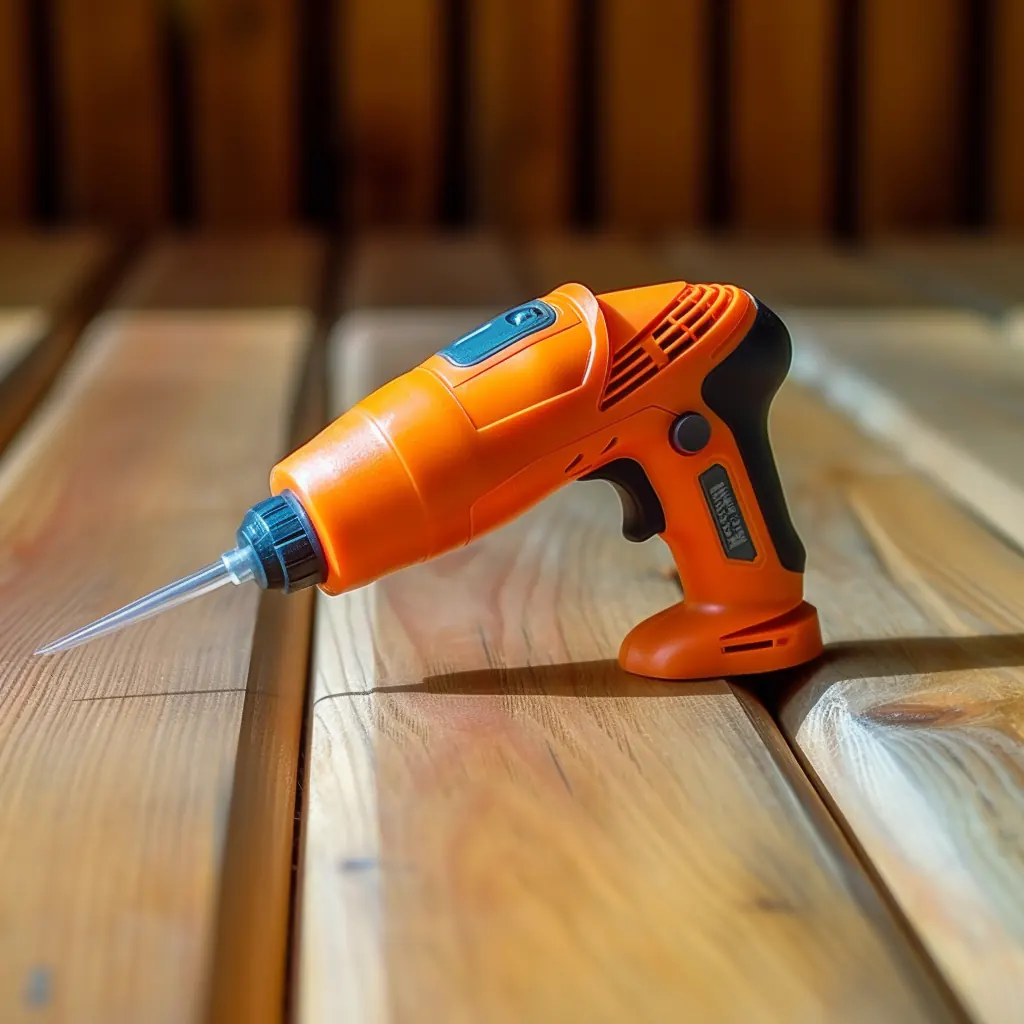
Best Hot Glue for Wood
Even though hot glue is not specially designed for wood, there’re some pretty good hot glue products in the market that provide a versatile durable bond for the money we spend.
Here’s the best hot melt glue for woodworking.
- Power adhesive 7718
- Surebonder 739
- AD Tech 962
- Titebond
- Power Adhesive Tec Bond 23
- Polyurethane PUR Hot Melt glue
So, let’s discuss the qualities of each of those hot glue products and find their applications in detail.
Power Adhesive 7718
Powe adhesive 7718 is a polyamide hot glue stick that works on wood pretty well. It is tough and has a low viscosity.
It has a short open time and high heat resistance.
Power adhesive 7718 can be used to bond wood with rough difficult surfaces because of its excellent bonding capabilities.
Here’re the major qualities and properties of Power Adhesive 7718 useful in woodworking.
| Glue Compatibility | ½” Glue sticks |
| Materials | Wood, Glass, Metal, Plastic |
| Properties | Heat resistant, Cold-resistant, Polyamide |
| Set speed | Medium |
| Available colors | Available in many colors |
| Open time | Short |
| Application Temperature | 350-4200F (176-2150C) |
Surebonder 739
Surebonder 739 is a high-performance hot glue stick that can use to repair dents and it can make one of the strongest bonds with wood.
Surebond 739 hot glue stick is shock-resistant at both ambient.
Therefore bonds create with wood are highly durable and have good strength than many other bonds created by other types of hot glue.
Most importantly, Surebond 739 works pretty well on wood even at low-temperature levels.
Here’re the major qualities and properties of Power Surebond 739 useful in woodworking.
| Glue Compatibility | ½” Glue sticks |
| Materials | Wood, Glass, Ceramic, Metal, Plastic |
| Properties | Shock resistant, Ethylene Vinyl Acetate |
| Set speed | Fast |
| Available colors | Amber clear |
| Open time | 25 seconds |
| Application Temperature | 3750F (1900C) |
AD Tech 962
AD tech 962 is one of the best-selling hot glue stick products available in the market.
It can make an excellent bond with wood and other surfaces. AD tech 962 hot glue sticks come in various sizes.
According to the experts, AD tech 962 can be used for high-volume applications and the open time is medium. Plus, it offers a high delivery rate.
Here’re the major qualities and properties of Power AD Tech 962 useful in woodworking.
| Glue Compatibility | ½”, 5/8”, 1 3/4” Glue sticks |
| Materials | Wood, Fabric, Cardboard |
| Properties | Heat resistant |
| Set speed | Fast |
| Available colors | Tan |
| Open time | 30 – 40 seconds |
| Application Temperature | 3500F (1760C) |
Titebond
Titebond is a popular hot glue product formulated with HiPURformer System. They are waterproof and set times to vary from 30 to 60 seconds.
Most importantly Titebond hot glue is great for both interior and exterior usage.
Titebond WW30 and WW60 products are great for wood-to-wood and wood-to-wood composite bindings.
They can be used for gap-filling purposes as well.
According to the Titebond, clamp the items you want to bond for about 30 minutes and wait for at least a day before stressing the wood joint.
Here’re some major qualities and properties of Titebond hot glue
| Glue Type | PUR Hot Melt (Polyurethane) |
| Materials | Bonds with anything |
| Properties | High strength, Waterproof, Solvent-free, Epoxy mixing, Non-flamable |
| Open time | Fast (30-60 seconds) |
| Available colors | Translucent |
| Assembly time | 25 – 30 minutes |
| Application Temperature | Above 500F (Above 100C) |
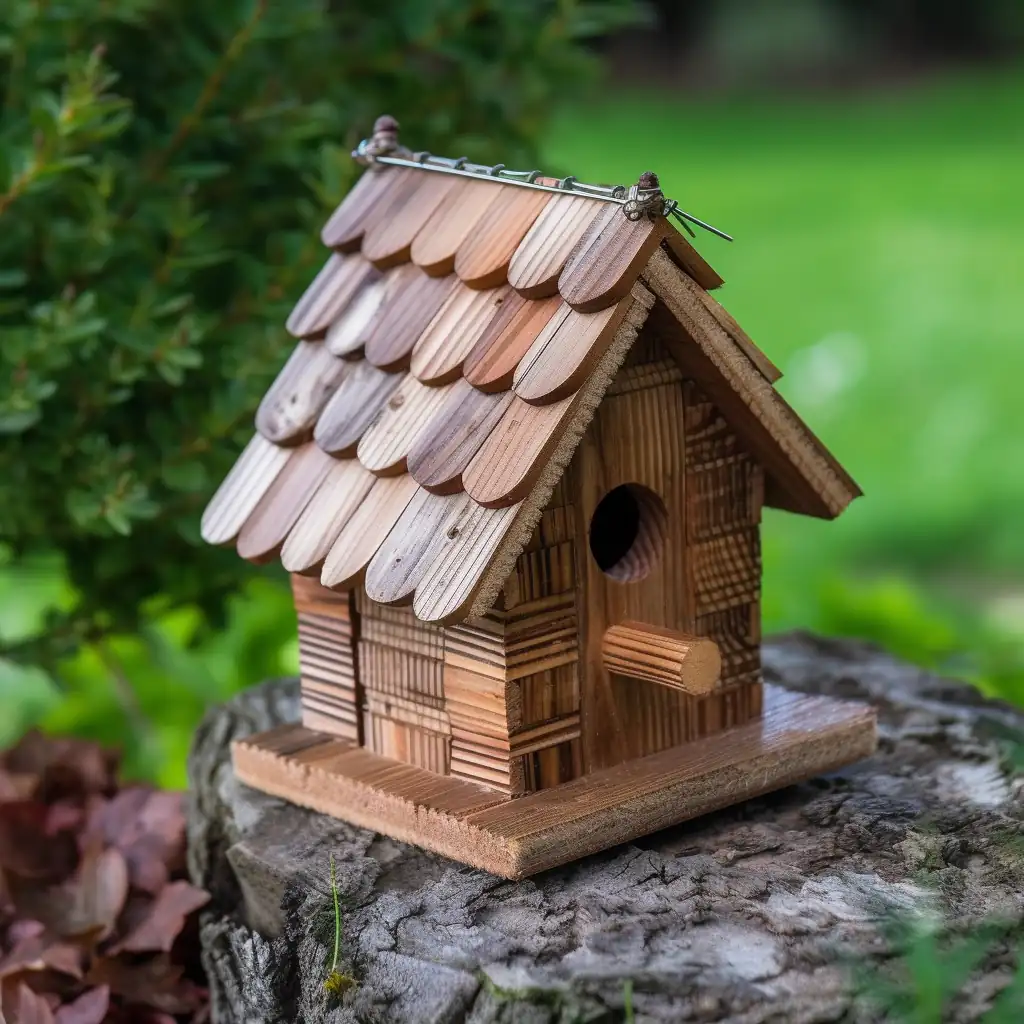
Power Adhesive Tec Bond 23
Power adhesive Tec bond 23 is a long-time hot glue stick that works perfectly on wood.
It has good bonding characteristics not only to wood but also with plastic, paper, and light metals.
Power adhesive Tec bond 23 is perfect for crafting projects and gap-filling applications.
Here’re some major qualities and properties of Power Adhesive Tec Bond 23 hot glue
| Glue Compatibility | ½”, 5/8”, 1 3/4” Glue sticks |
| Materials | Wood, Plastic, Light metal |
| Properties | Nonflammable, no explosion hazard |
| Set speed | Medium |
| Available colors | Tan |
| Open time | Long |
| Application Temperature | 3800F (1930C) |
Polyurethane PUR Hot Melt Glue
Polyurethane PUR hot melt glue is an adhesive with both characteristics of hot glue sticks and bulk hot melt.
It can make a strong durable bond with wood after adhesive sets.
It comes in various sizes and the strength of the bond eventually increases when it reacts with atmospheric air.
Therefore, Polyurethane PUR hot melt glue is able to make one of the strongest bonds with wood than other hot glue types due to the chemical process inside.
Here’re some major qualities and properties of Polyurethane PUR hot melt glue.
| Glue Type | PUR Hot Melt (Polyurethane) |
| Materials | Bonds with anything |
| Properties | High strength, Stand against stress, Easy to use, Cold-resistant, Heat resistant, Non-flammable |
| Open time | Fast (30, 60, 90, 120, 150 seconds) |
| Available colors | Translucent |
| Assembly time | 45 minutes |
| Application Temperature | Above 500F (Above 100C) |
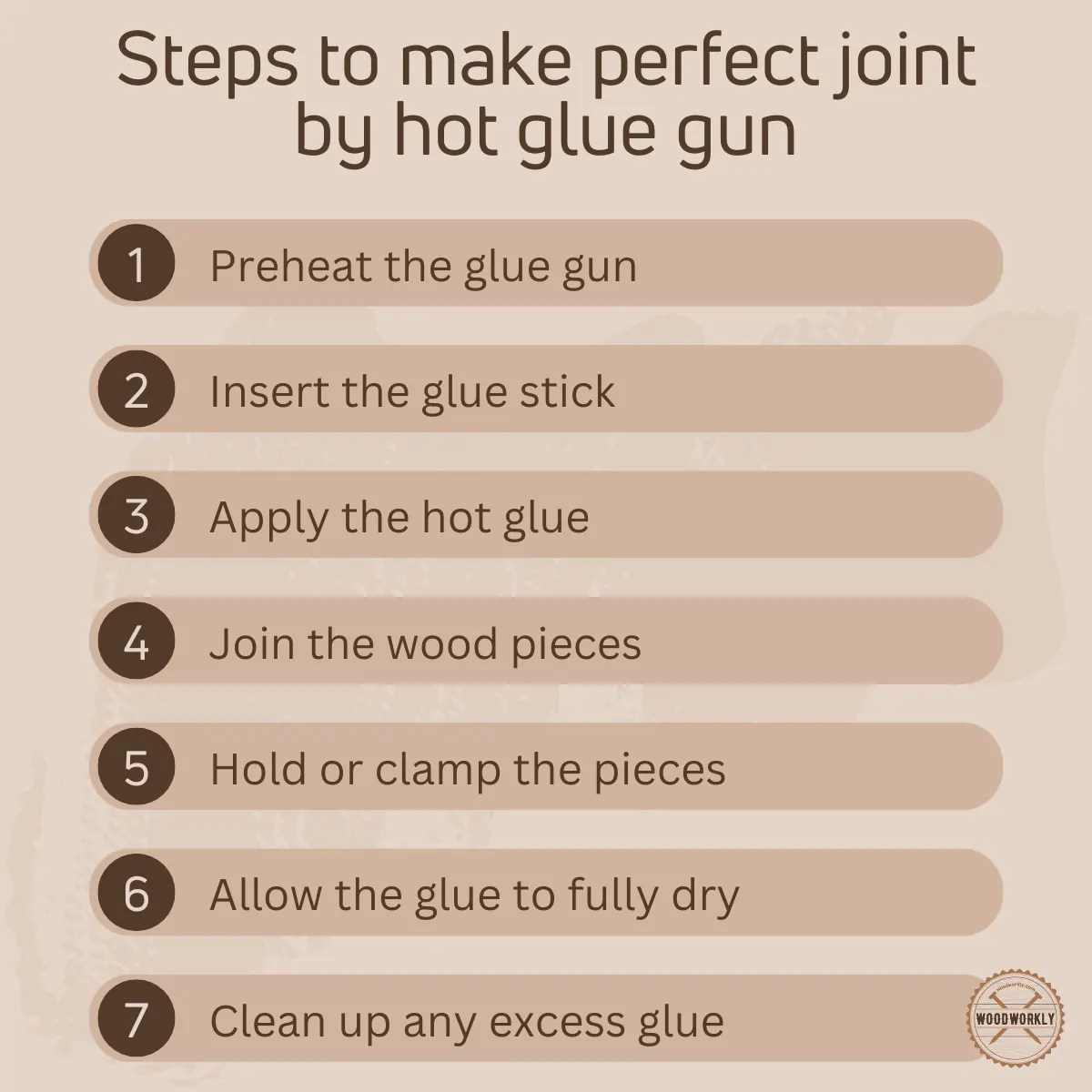
Uses Of Hot Glue On Wood
Hot glue, with its quick bonding time and versatility, offers a wide array of uses in woodworking.
From smaller craft projects to aiding in more substantial DIY ventures, this adhesive can be a handy companion.
So, whether you’re a seasoned pro or a beginner in woodworking, let’s explore the different ways you can utilize hot glue on wood!
Craft Projects and Decorative Touches
If you’re a fan of adding personal, creative touches to your home, hot glue is a tool you should have in your arsenal.
It’s particularly useful in crafting projects involving wood, thanks to its easy application and fast drying time.
Let’s say you’re working on a decorative wooden picture frame.
Hot glue can help attach embellishments like small wooden cutouts, beads, fabric pieces, or even stones to the frame.
You can also use it to create textures and patterns directly on the wood—just remember to let it dry thoroughly before painting over it.
Making Temporary Bonds
Hot glue is also great for creating temporary bonds.
This comes in handy during woodworking projects where you need to hold pieces together before permanently securing them with screws or nails.
Imagine you’re building a small bookshelf.
Aligning and keeping the shelves in place while you drill or nail can be tricky.
Here, hot glue can serve as a temporary hold, allowing you to work hands-free and ensuring everything is in the right place before the final attachment.
Filling Gaps and Cracks
Hot glue can also be used as a filler for small gaps or cracks in wooden objects.
This might not be the perfect solution for larger, weight-bearing pieces, but for smaller, decorative items or DIY projects, it’s quite efficient.
For instance, you have a wooden toy car with small gaps between the pieces.
Applying a small amount of hot glue can fill these spaces, providing a smooth finish once it’s painted over.
Minor Repairs and Reinforcements
While it may not be the most robust adhesive, hot glue can come to the rescue for minor repairs.
A loose wooden knob on a drawer or a wobbly leg on a small stool?
Hot glue can provide a temporary, quick fix until you find a more permanent solution.
Similarly, it can be used as a reinforcement for other adhesives.
Suppose you’re gluing two pieces of wood with a stronger adhesive that takes longer to dry.
Applying hot glue at the edges can provide an immediate hold while the primary adhesive cures.
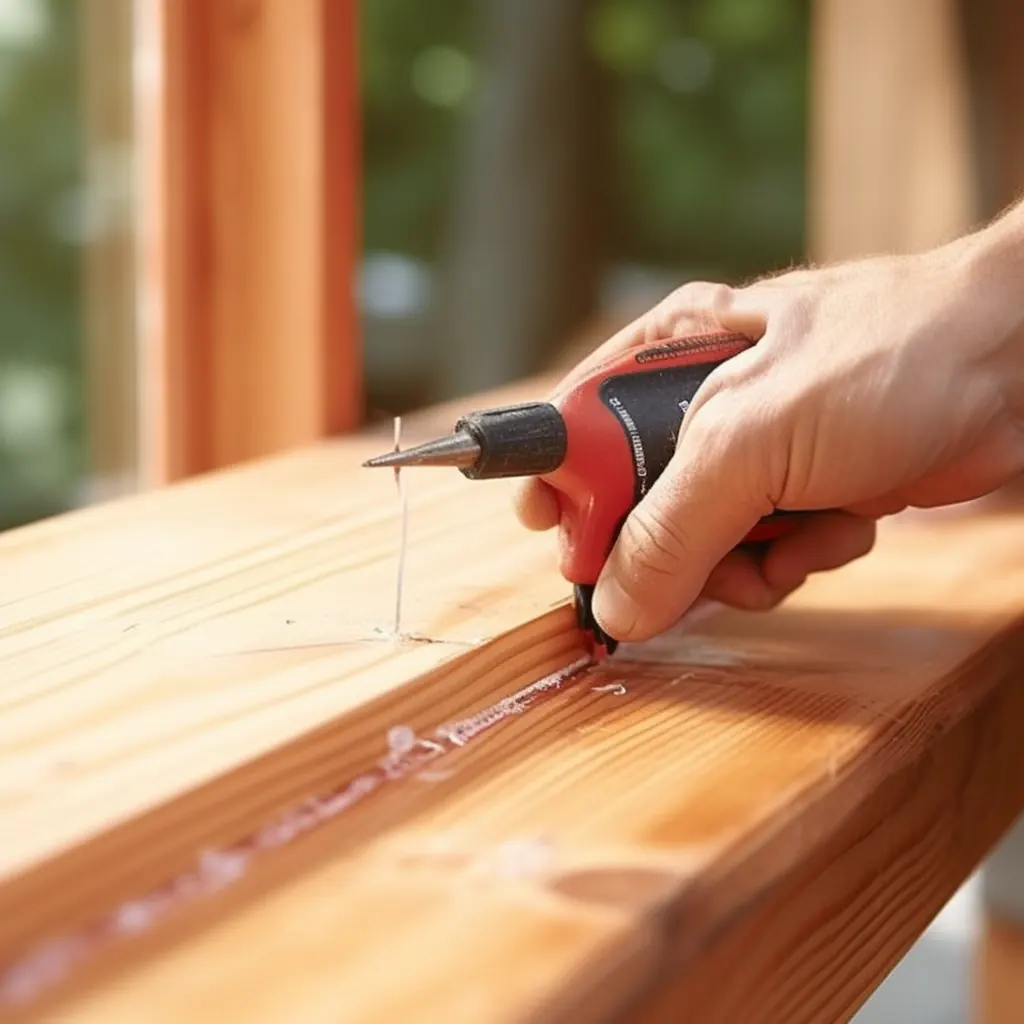
Is Hot Glue Permanent or Temporary?
The answer to whether hot glue is permanent or temporary is, well, a bit of both.
The permanence of hot glue depends heavily on the materials being glued, the conditions in which the glued object will exist, and the demands placed upon the bond.
Let’s break down when hot glue might be a temporary fix and when it might provide a more permanent solution.
Hot Glue as a Temporary Bond
As we touched on earlier, hot glue excels as a temporary adhesive in many situations.
It’s incredibly useful when you need a quick hold—say, you’re piecing together a woodworking project, and you need the components to stay put while you make more permanent attachments.
A memorable example of this temporary usage happened when I was building a birdhouse with my nephew.
We needed to secure the pieces together temporarily before screwing them into place.
A little bit of hot glue did the trick wonderfully, holding the parts steady while we worked.
Similarly, if you’re a hobbyist model maker or love crafting, you’ll find that hot glue is a perfect tool for temporary bonds, especially when you’re prototyping or trying different design arrangements.
The beauty of hot glue is that it’s pretty easy to remove without causing damage if you change your mind or make a mistake.
Hot Glue as a Permanent Bond
In contrast, hot glue can indeed serve as a more permanent adhesive in some cases.
For lightweight materials and non-load-bearing applications—like attaching fabric to wood, securing embellishments, or bonding foam—hot glue can form a strong, lasting bond.
I’ll never forget this one time when a decorative knob fell off from an antique wooden cabinet.
I didn’t have any wood adhesive at hand, so I used hot glue. To my surprise, it held up for years and is still intact.
But, of course, “permanent” with hot glue isn’t quite the same as with more robust adhesives. If subjected to enough force or high temperatures, hot glue bonds can weaken or fail.
This is why, for vital structural joints or high-stress applications, traditional wood glues, epoxies, or mechanical fasteners tend to be better choices.
Factors Affecting The Permanence Of Hot Glue
Here’re several factors that can affect how long a hot glue bond lasts,
- Materials being glued
- the quality of the glue
- The temperature of the glue
- The application method
- Environmental conditions
For example, hot glue tends to hold up better in dry, indoor environments and can weaken in high heat or excessive moisture.
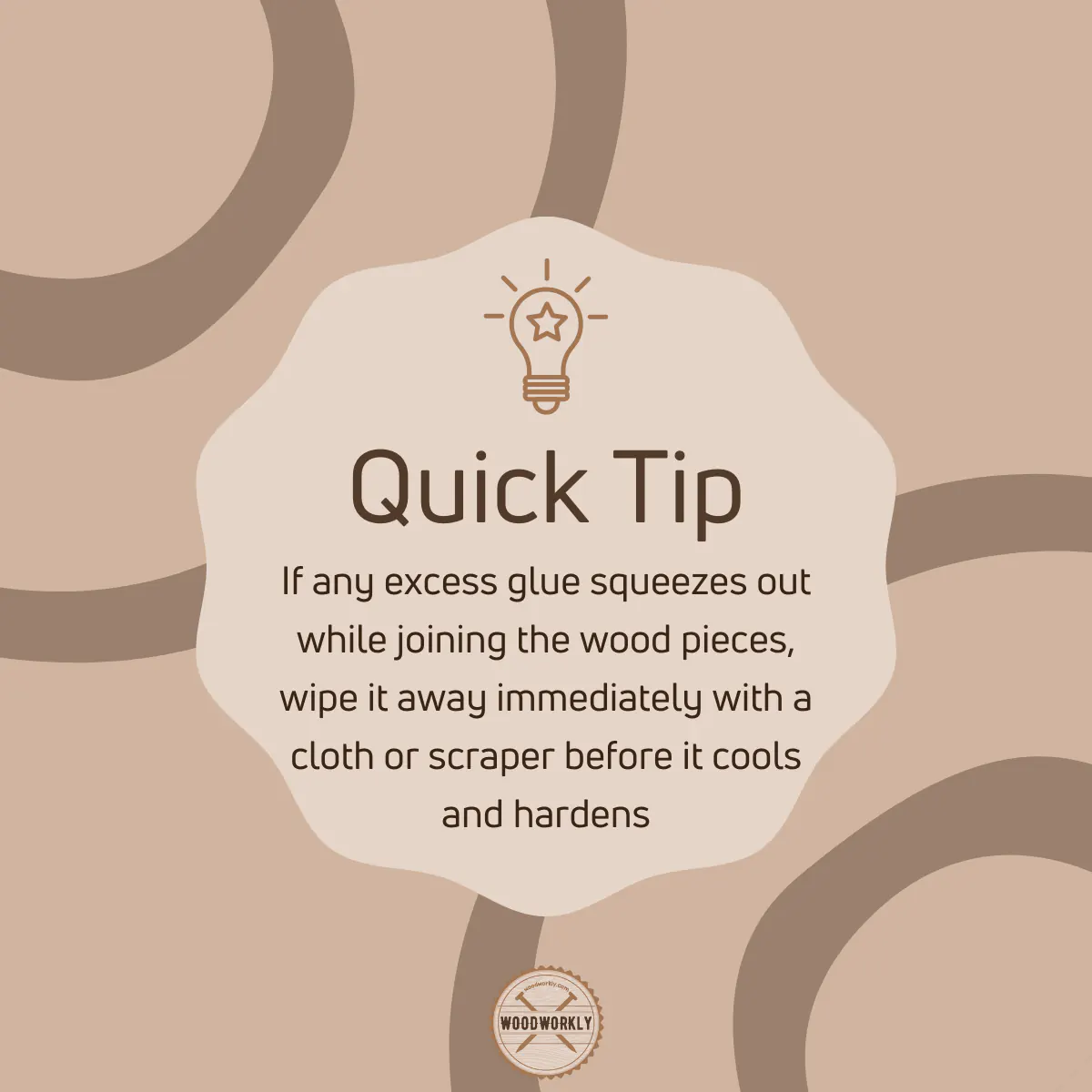
Wood Glue vs Hot Glue
When it comes to attaching two pieces of wood together, you’ll often find yourself facing a choice: should you use wood glue or hot glue?
While both are commonly used in various crafting and woodworking projects, each has its unique strengths and weaknesses.
Let’s dig in to find out which one you should reach for, depending on your specific project needs.
Strength and Durability
Wood Glue
Wood glue, such as PVA (polyvinyl acetate) or hide glue, creates an extremely strong bond between two pieces of wood.
This is because it penetrates the wood fibers and hardens, creating a joint often stronger than the wood itself.
For example, I once made a bookshelf using wood glue for the joints, and it’s still standing strong and holding a ton of books years later.
Hot Glue
Hot glue, on the other hand, adheres to the surface of the wood rather than penetrating it.
While it can create a strong bond quickly, it’s generally not as strong or durable as wood glue.
It’s worth noting, though, that for non-load-bearing applications—like attaching decorations—it can be more than sufficient.
Drying and Clamping Time
Wood Glue
Wood glue typically takes longer to dry than hot glue.
Depending on the specific type and conditions, wood glue may require several hours or even more than a day to fully cure.
During this time, the pieces usually need to be clamped together, which can extend the total working time of a project.
Hot Glue
Hot glue, on the other hand, hardens almost immediately upon cooling, which can be within minutes.
This makes it a great option when you need to move quickly or don’t have clamps handy.
Flexibility and Reversibility
Wood Glue
Wood glue tends to create rigid joints, which can be great for structural stability.
However, this also means there’s little room for error.
Once it’s dried, wood glue is difficult to reverse without potentially damaging the wood.
Hot Glue
Hot glue provides a bit more flexibility.
If you make a mistake or change your mind, it’s easier to remove hot glue from wood without causing damage.
Also, because it adheres to a wide range of materials, it can be more versatile for mixed media projects.
Application and Cleanup
Wood Glue
Applying wood glue can be a bit messier, as it requires spreading the glue on the surfaces before joining them together.
Cleanup, though, is typically straightforward—just wipe away any excess before it dries.
Hot Glue
Hot glue requires a glue gun for application, which may require a bit more setup but also allows for more precision.
It can be a little trickier to clean up, as you’ll need to wait for the glue to cool and harden before you can remove any excess.
Summary Table
| Characteristic | Wood Glue | Hot Glue |
|---|---|---|
| Strength and Durability | Stronger, more durable | Less strong, less durable |
| Drying and Clamping Time | Longer drying time, clamping required | Quick set, no clamping needed |
| Flexibility and Reversibility | Rigid joints, hard to reverse | More flexible, easier to reverse |
| Application and Cleanup | Messier application, easier cleanup | More precision in application, trickier cleanup |
As you can see, choosing between wood glue and hot glue often comes down to the specific needs of your project.
Wood glue generally provides a stronger, more durable bond but requires more time and precision. Hot glue, while not as strong, sets quickly and offers more flexibility and reversibility.
Understanding the differences will help you make the best adhesive choice for your woodworking and crafting needs.
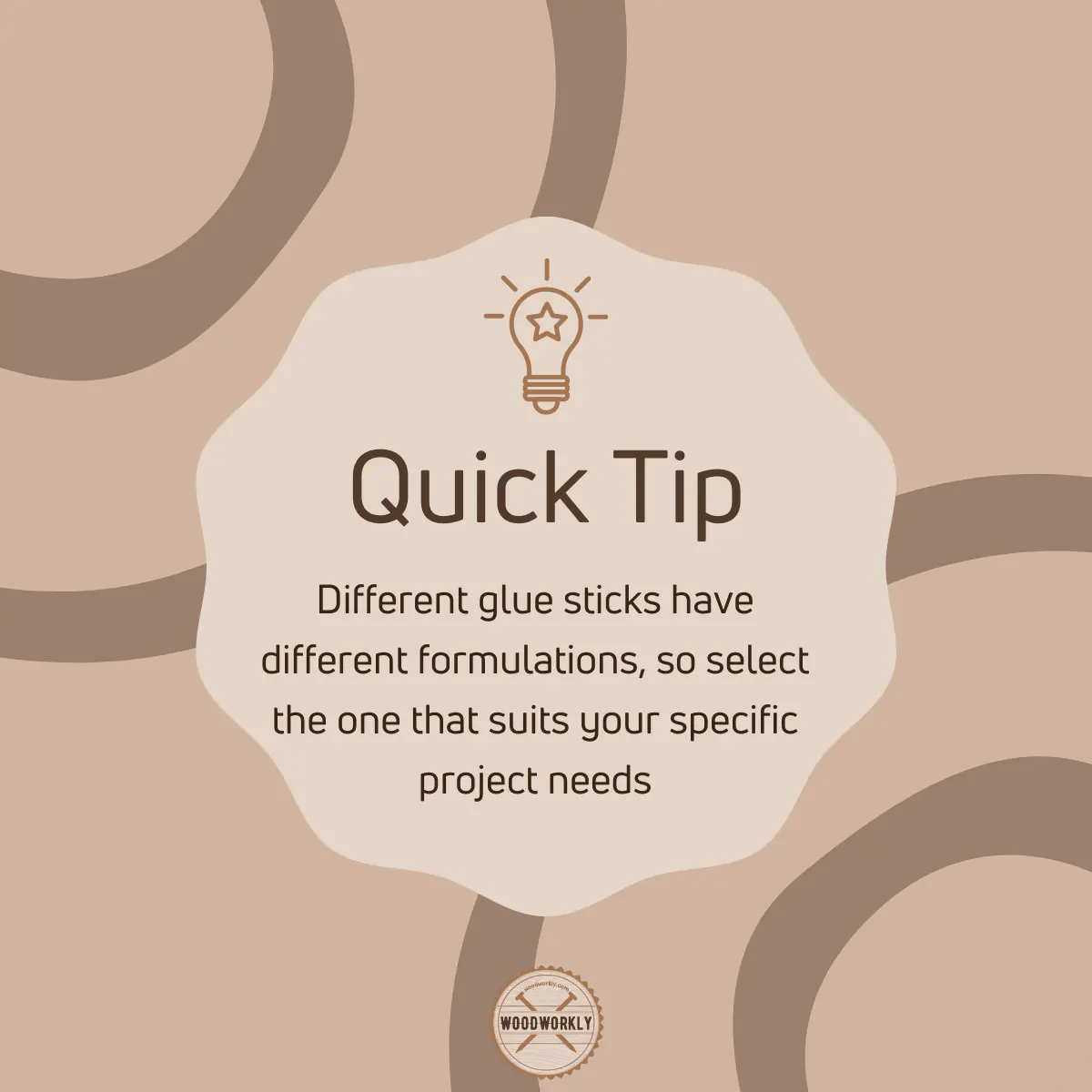
How to Use a Hot Glue Gun on Wood
Using a hot glue gun can be a great way to bond materials quickly, especially in craft projects or quick repairs.
Here, we’ll go step by step through the process of using a hot glue gun on wood.
Gathering Your Supplies
Before you start, make sure you have everything you need at hand.
In addition to your hot glue gun, you’ll need hot glue sticks of the appropriate size, the pieces of wood you’re joining, and any safety equipment like heat-resistant gloves or safety glasses.
Trust me, having everything ready before you start will make the whole process smoother.
Warming up the Glue Gun
Plug your hot glue gun into an outlet and insert a glue stick. It may take a few minutes for the glue to heat up.
Most hot glue guns have an indicator light that will let you know when it’s ready.
I like to use this time to arrange the pieces of wood I’m working with.
Applying the Glue
Once your glue gun is warmed up, it’s time to apply the glue. Gently squeeze the trigger to extrude the hot glue onto the surface of the wood.
Aim for an even application and be mindful of the quantity. Too much glue can make a mess, while too little might not provide a strong bond.
Also, it’s always better to apply glue to both surfaces you’re joining for a firmer bond.
Joining the Pieces
Immediately after applying the glue, press the two pieces of wood together.
Be sure to align them properly as you’ll only have a few seconds to adjust before the glue starts to set.
For larger pieces, it can be helpful to have a friend lend an extra pair of hands.
Letting it Cool
Allow the glue to cool for a few minutes. As it cools, it will harden and form a bond between the two pieces of wood.
I find that this is the perfect time to clean up any stray glue strings or blobs with a piece of scrap wood or a craft stick.
Safety First
Always remember, safety is paramount when using a hot glue gun. The glue and the nozzle of the gun can get very hot.
I’ve had my fair share of hot glue mishaps, and trust me, it’s not pleasant.
So, it’s always a good idea to wear heat-resistant gloves and safety glasses, and to keep a bowl of cold water nearby just in case.
Now I’m going to share with you some tips and tricks which are useful when applying hot glue on wood.
I’ve learned the below tips by experience and these will make your gluing project a lot easier.
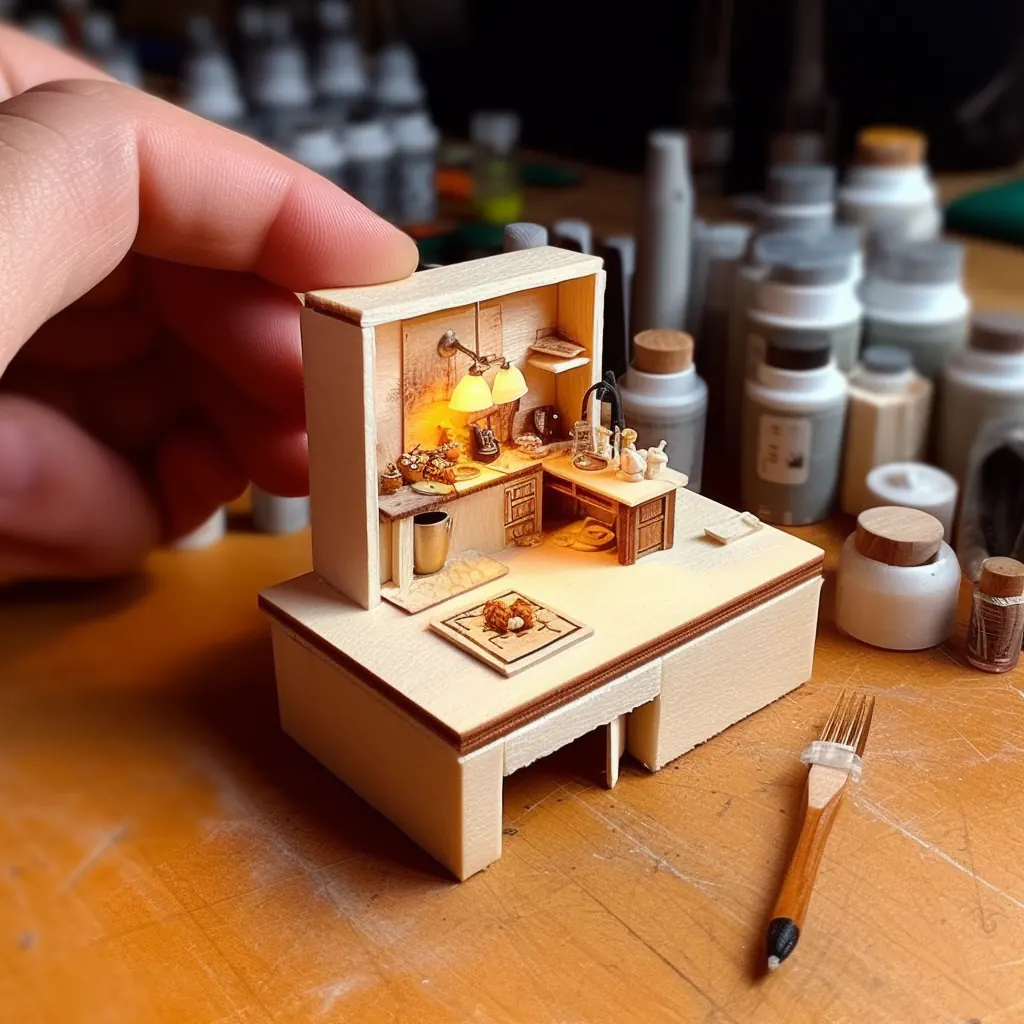
Tips for Using Hot Glue on Wood
From my numerous encounters with hot glue guns and their nifty uses, I’ve picked up a few handy tips and tricks.
So here are some tips for using hot glue on wood to ensure you get the best results.
1. Choose the Right Glue Stick
First things first, you need to choose the right glue stick.
Not all glue sticks are made equal, and some are better suited to wood than others.
Make sure you opt for a high-temperature glue stick designed for wood to get the best adhesion and strength.
2. Clean Your Wood Surfaces
Before you apply hot glue, clean your wood surfaces thoroughly.
Any dirt, dust, or oils can interfere with the bond between the glue and the wood.
I usually just give the wood a quick wipe with a dry cloth and it’s good to go.
3. Warm Your Wood
If you’re working in a cold environment, try warming the wood slightly before applying hot glue.
The glue tends to harden very quickly on cold surfaces, which can prevent a strong bond from forming.
A hairdryer or heat gun can be a useful tool for this – just remember not to overdo it!
4. Use the Right Amount of Glue
It can be tempting to slather on hot glue, but remember that a little goes a long way.
Too much glue can squeeze out the sides when you join your wood pieces, creating a mess.
But too little, and your bond might not be strong enough. Practice will help you get a feel for the right amount.
5. Work Fast
Hot glue starts to cool and set as soon as it leaves the gun, so you’ll need to work quickly.
Have your wood pieces and tools ready to go before you apply the glue, and remember – you only have a few seconds to adjust your pieces once they’re glued together!
6. Be Patient
While hot glue does set quickly, it’s important to give it ample time to fully cool and cure before you start moving your wood pieces around.
Rushing this step could result in a weaker bond, and nobody wants their project to fall apart at the last moment.
I find it’s always best to wait a few extra minutes just to be safe.
There you have it – some of my top tips for using hot glue on wood. Remember, practice makes perfect.
Congrats folks! Now you know does hot glue work on wood and how to use it on wood properly to get promising results as you wish.
Now I’m going to show you some occasions (wood projects) where hot glue can be applied.
Does Hot Glue Work on Painted Wood?
Yes, hot glue works perfectly on painted wood. Hot glue is able to penetrate through the painted surface of the wood and make a wood joint to stick the wood pieces together.
Plus, hot glue work on stained wood as well.
Water-based paint covers up porous structures of the wood to less extent than oil-based paint. Therefore, hot glue work slightly better on water-based painted wood than oil-based painted wood.
Ultimately, when the wood porosity is high it has a higher tendency to work well with hot glue.
Does Hot Glue Work on Damaged Wood?
Yes, Hot glue work well on damaged wood as long as the surfaces have enough porosity.
Hot glue is able to repair damaged wood by working as a gap filler.
But if the wood is damaged from the interior, it’ll be a difficult task to stick wood pieces together due to poor structural strength.
Does Hot Glue Work on Metal to Wood?
Yes, Hot glue works well on light metal to wood.
If the metal is heavy, hot glue the strength of the hot glue bond is poor and with enough force, the bonded wood pieces can be pulled off so easily.
Power adhesive Tec bond 23 is a quality hot glue product that can stick light metal to the wood.
Does Hot Glue Work on Balsa Wood?
If Balsa wood pieces and small and thin, hot glue work perfectly on them.
But if the weight of Balsa wood pieces is high, hot glue is not a good option because it cannot make a strong bond as other wood glue types.
Hot glue adheres to smaller surfaces. With enough clamp pressure and sufficient glue amount, it can make a good bond on Balsa wood.
What Can You Use Instead of Hot Glue On Wood?
Here’re the best alternatives that you can use instead of hot glue to make a strong bond with the wood,
- Liquid glue
- Spray adhesive
- Fabric glue
- PVA glue
- Epoxy resin
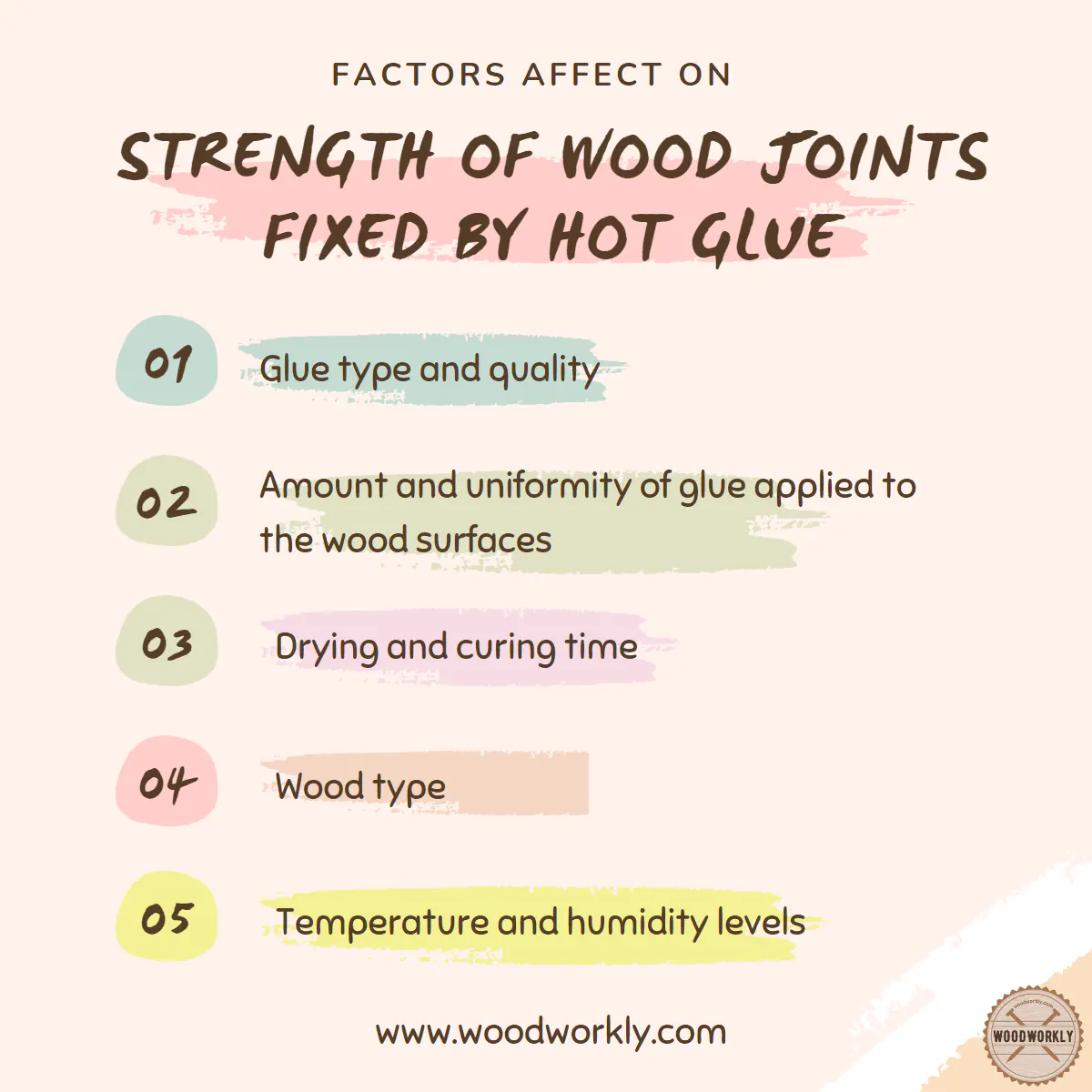
So, let’s answer some frequently asked questions.
FAQs
Can hot glue be removed from wood?
Yes, hot glue can be removed from wood by gently prying it away with a putty knife or a similar tool. It’s easier to remove when it’s still warm, but be careful not to burn yourself!
Is hot glue waterproof on wood?
While hot glue is moderately water-resistant, it is not fully waterproof. If the project will be exposed to water or humid conditions, consider using a waterproof adhesive.
Can hot glue damage wood?
If used properly, hot glue should not damage wood. However, be cautious not to leave the hot tip of the glue gun on the wood for too long as it may scorch or discolor the surface.
Do I need to prep the wood before using hot glue?
Yes, it’s recommended to clean the wood surface from any dust or oil before applying hot glue to ensure a better bond. For cold environments, consider warming the wood slightly.
Did I cover all you wanted to know about: Does Hot Glue Work On wood?
In this article, I have deeply discussed does hot glue work on wood and how strong is hot glue on wood.
Furthermore, I’ve talked about what is the best hot glue for wood with their qualities and properties as well.
Hot glue does work on wood and is often used in crafting and light woodworking projects. While it may not provide the same strength as wood glue for heavy-duty use, it dries quickly and is easy to use, making it a practical option for many applications.
Plus, I’ve answered some frequently asked questions as well.
Hope you’ve gained pretty good knowledge about how hot glue work on wood.
So, let’s head into your next woodworking project with hot glue and learn from regular practice. Keep practicing until you become pro at using hot glue!